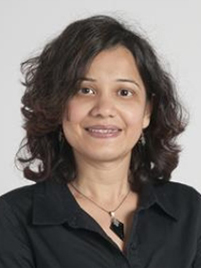Our laboratory’s work is broadly focused on understanding the role of abnormal neural circuits in strabismus and amblyopia and apply novel strategies for their treatment.
My laboratory based at the Cleveland Clinic focuses on research techniques involving visual psychophysics and eye movement data acquisition and analysis using portable as well as a laboratory-based video-oculography system in children.
Areas of Interest
- To understand the efferent visual neurophysiology in the pathogenesis of amblyopia: Psychophysical studies in healthy subjects have suggested that small fixational eye movements, such as micro-saccades are critical in visual perception and prevention of visual fading. Our laboratory has the unique technology that allows us to capture such fixational eye movements non-invasively with excellent resolution and high sampling rate in pediatric subjects. We measure and quantify fixational eye movements while the amblyopic and healthy children are viewing simple visual targets, complex visual scenes, and performing visual tasks requiring delineation of fine details, for example identifying picture differences. We have shown that fixational eye movements are altered in amblyopes not only in the amblyopic eye but also in the fellow eye. This suggests that amblyopia is not primarily a monocular disorder but is a binocular visual disorder. We have also shown that such changes might lead to well-known crowding phenomenon in amblyopia. In addition, abnormal fixation can be a useful screening tool to identify and monitor treatment of amblyopia in preverbal children.
- To investigate different treatment modalities for children with amblyopia: We are doing a pilot study in collaboration with Dr. Plow’s Lab to investigate the use of non-invasive brain stimulation in older children and adults with residual amblyopia. We have also participated in several multicenter clinical trials assessing different treatment options including patching in the management of these patients.
- To quantitatively study the eye movements to gain insights into the mechanisms causing strabismus: We have used eye movement as a tool to identify quantitative markers in various forms of strabismus and use these to design surgical approaches to achieve better anatomical and functional outcomes.
- To understand the effects of focal lesions of the central nervous system in the pathophysiology of abnormal eye movements, gaze holding deficits, and strabismus: Such studies of “disease model” allows us to identify areas of the nervous system responsible for causing commonly encountered pediatric ocular motility disorders like strabismus and nystagmus.
We are addressing these questions across federally funded through the Clinical and Translational Collaborative of Cleveland and several Private Foundation Research grants.
Publications (Select)
Entire publication list can be found here.
- Ghasia FF, Otero-Millan J, Shaikh AG. Abnormal fixational eye movements in strabismus. Br J Ophthalmol. 2018 Feb;102(2):253–259. doi: 10.1136/bjophthalmol-2017-310346 Pubmed PMID: 28698242
- Shaikh AG, Antoniades C, Fitzgerald J, Ghasia FF. Effects of Deep Brain Stimulation on Eye Movements and Vestibular Function. Front Neurol. 2018;9:444. doi: 10.3389/fneur.2018.00444 Pubmed PMID: 29946295
- Kang SL, Shaikh AG, Ghasia FF. Vergence and Strabismus in Neurodegenerative Disorders. Front Neurol. 2018;9:299. doi: 10.3389/fneur.2018.00299 Pubmed PMID: 29867716
- Shaikh AG, Ghasia FF. Novel Eye Movement Disorders in Whipple’s Disease-Staircase Horizontal Saccades, Gaze-Evoked Nystagmus, and Esotropia. Front Neurol. 2017;8:321. doi: 10.3389/fneur.2017.00321 Pubmed PMID: 28744253
- Shaikh AG, Ghasia FF. Fixational saccades are more disconjugate in adults than in children. PLoS One. 2017 Apr 13;12(4):e0175295. doi: 10.1371/journal.pone.0175295. eCollection 2017. PubMed PMID: 28406944; PubMed Central PMCID: PMC5391133.
- Ghasia FF, Otero-Millan J, Shaikh AG: Fixational eye movements in strabismus. BJO (in press)
- Shaikh AG, Otero-Millan J,Kumar P, Ghasia FF: Abnormal fixational eye movements in amblyopia. Plos One March 2016 1; 11(3).
- Ghasia F, Brunstrom-Hernandez J, Tychsen L. Repair of strabismus and binocular fusion in children with cerebral palsy: gross motor function classification scale. Invest Ophthalmol Vis Sci. 2011 Sep 29;52(10):7664-71.
- Ghasia F, Brunstom J, Tychsen L. Visual acuity and visually evoked responses in children with cerebral palsy: Gross Motor Function Classification Scale. Br J Ophthalmol. 2009 Aug;93(8):1068-72.
- Ghasia FF, Meng H, Angelaki DE. Neural correlates of forward and inverse models for eye movements: evidence from three-dimensional kinematics. J Neurosci. 2008 May 7;28(19):5082-7.
- Ghasia F, Brunstrom J, Gordon M, Tychsen L. Frequency and severity of visual sensory and motor deficits in children with cerebral palsy: gross motor function classification scale. Invest Ophthalmol Vis Sci. 2008 Feb;49(2):572-80.
- Shaikh AG, Green AM, Ghasia FF, Newlands SD, Dickman JD, Angelaki DE. Sensory convergence solves a motion ambiguity problem.Curr Biol. 2005 Sep 20;15(18):1657-62.
- Ghasia FF, Angelaki DE. Do motoneurons encode the noncommutativity of ocular rotations? Neuron. 2005 Jul 21;47(2):281-93.
- Ghasia F, Tychsen L. Horizontal and vertical optokinetic eye movements in macaque monkeys with infantile strabismus: directional bias and crosstalk. Invest Ophthalmol Vis Sci. 2014 Jan 13;55(1):265-74
- Ghasia FF, Shaikh AG: Source of high frequency oscillations in oblique saccade trajectory. Experiment Eye Research. 2014 Feb 19
- Ghasia FF, Gulati D, Westbrook EL, Shaikh AG: Viewing condition dependence of the gaze-evoked nystagmus in Arnold Chiari type 1 malformation. J Neurological Science. 2014 Feb 11
- Shaikh AG, Ghasia FF, Delong MR, Jinnah HA, Freeman A, Factor SA. Ocular palatal tremor plus dystonia-new syndromic association. Movt Disorder Clinical Practice. 2015 Sept 1; 2(3):267-270.
- Shaikh AG, Ghasia FF: Neuro-ophthalmology of Chiari 1 malformations. Exp Review of Ophthalmology
- Ghasia FF, Wilmot G, Ahmed A, Shaikh AG: Strabismus and Micro-opsoclonus in Machado-Joseph Disease Cerebellum 2015 Aug 26 (Epub ahead of print)
- Shaikh AG, Ghasia FF: Misdirected horizontal saccades in pan-cerebellar atrophy. J Neurolog Science 2015 Aug 15;355 (1-2). 125-30
- Ghasia FF, Shaikh AG, Jacobs J, Walker MF. Cross coupled eye movement supports neural origin of pattern strabismus. IOVS 2015 May 56(5):2855-66
- Shaikh AG, Ghasia FF, Dickman JD, Angelaki DE. Properties of cerebellar fastigial neurons during translation, rotation, and eye movements. J Neurophysiol. 2005 Feb;93(2):853-63.

